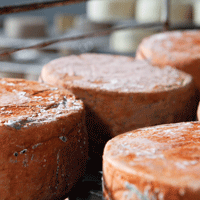Canada’s artisanal cheese industry is expanding rapidly, and producing some of the finest cheeses in the world, according to Georg Kolesnikovs, founder of The Great Canadian Cheese Festival, held annually in Prince Edward County, Ont. “I was in Italy for the Slow Food Cheese Festival and sampled some outstanding European cheeses,” he says. “But Canadian artisan cheeses have so much character and nuance, they match anything in Europe.”
He’s not alone in this opinion. “Canadians are making phenomenal cheeses. I’m more wowed by ours than I was on a recent trip sampling cheese in Europe,” attests Afrim Pristine, cheesemonger at The Cheese Boutique in Toronto. But, he adds, the industry and enthusiasm for it here is still in its infancy. “We wouldn’t even have had this conversation seven years ago, but customers today are asking for Canadian cheese and they want to know where it was made, how long it was aged, is it raw or pasteurized?”
Customers may love cheese, but their buying habits tell a different story. According to Linda Strachan, foodservice industry analyst at the NPD Group, the total servings of cheese declined by two per cent for the year ending February 2012, with more than 14-million servings at commercial restaurants. “Less than one per cent of all meals or snacks include cheese on its own, not as a component of another dish like a salad,” she says. “The good news is there’s lots of room for growth.”
And Strachan anticipates growth. “There is interest in locally sourced items like artisan cheese,” she adds. “In NPD’s latest ‘FSR Report: What Customers Want,’ we asked customers what they would like to see more of at full-serve restaurants. The most frequently mentioned menu preferences include food sourced from Canada (39 per cent) and smaller/mini portions of a few different things (36 per cent), followed by regionally inspired dishes (29 per cent).” A Canadian cheese plate meets the criteria, but producers still have their challenges.
Local Love
“We’re all surviving if not thriving,” says David Wood, owner of Saltspring Cheese in B.C. “There’s a lot of support for the artisan cheese market, but most of us are cheesemakers, not marketers.” Even for a successful company like his, with sales of more than $2 million annually, the drive to keep prices competitive means profits are low.
Many people have pointed to the closure of Fifth Town Artisan Cheese in Ontario as an example of why artisanal cheese isn’t viable. But its former owner and one of the founders of the Canadian Cheese Society, Petra Cooper, is adamant that’s not the case, “I would wrestle anyone to the mat that tries to lay this at the door of artisan cheese. Our problems came about because of a shareholder proxy fight and could have been prevented if we had dispute-resolution clauses from the outset.” Like Wood, she believes artisanal cheese will continue to be a force in the Canadian marketplace.
It helps to have the support of chefs such as Jamie Kennedy of Jamie Kennedy’s Kitch-ens. “The biggest seller at the wine bar was the cheese plate,” says the chef, who admits there are drawbacks. “There is a cost factor, which might make these a little unpalatable for many restaurateurs.” Nonetheless, he believes because more and more people value local food, as opposed to the global industrial alternatives, artisanal cheese will be viewed through a different lens. “People are concerned about food security and carbon footprint, and that will drive the market. And as distribution and marketing improves it will bring the price down.”
Toronto’s Pangaea attacks the problem by taking it on themselves. Already known for its homemade charcuterie, handmade, single-batch cheeses have been added to the menu. Chef de cuisine, Derek Bendig, uses organic cow’s milk, and goat’s and sheep’s milks, to create interesting blends and flavours. His starters come from Glengarry, an Ontario cheesemaker, and the leftover whey goes to make ricotta for gnocchi. “We’ve had a few disasters, but there have been some superb cheeses too,” says Bendig. For example, there’s “Gold Digger, a cow’s milk cheese we age three months, and an ash-rind pyramid of goat’s milk cheese.” His cheeses are aged in converted refrigerators, which hold the temperature and humidity in balance. “When you make it yourself, you’re putting a lot of yourself into the product,” he adds. “And that sells.”
The Cheese Stands Alone
Other restaurants sell cheese by making it the focus. At Vancouver’s Salt Tasting Room, guests can assemble their own tasting plate from a chalkboard selection of 10 cheeses, 10 meats and 10 condiments ($15 for three cheeses and three condiments). And at Gudrun Tasting Room in Vancouver, three 1.5-oz servings of cheese come with assorted fruits, nuts and preserves as well as sfilatino, an Italian wet-bread baguette ($21).
In Toronto, The Obikà Mozarella Bar serves soft, milky mozzarella di bufala Campana, burrata and affumicata (smok-ed), flown in from Italy twice a week. It’s about terroir for this chain with 16 branches in major world cities. A creamy, hand-formed ball of mozzarella served with prosciutto or grilled vegetables or its own version of pesto, ranges from $15 to $21.
Cheese Werks in Toronto is the brainchild of Kevin Durkee and Tom Douangmixay, a couple who believe the time has come for artisanal cheese. Their grilled sandwiches, made with cheeses from producers such as Balderson or Bothwell, (a major criterion is they must be free of modified milk ingredients) are named for Canadian cities. Toronto, for example, includes a choice of two of a trio of sliders reflecting the city’s ethnic neighbourhoods — Koreatown (with kimchi and gruyère), The Danforth (aged goat cheddar and tapenade) and Little Italy (buffalo mozzarella, tomato and fresh basil), all served on sourdough. Prices range from $7.50 to $10 with kettle chips and dills on the side.
An Education
Whether cheese is homemade, local or flown in from overseas, marketing is key. “It’s about the story, educating people about the product and its history,” says The Cheese Boutique’s Pristine, who teaches servers the story, so they understand basic flavour profiles. “Without the communication, there’s no love on the plate.”
Educating servers works. At Toronto’s Enoteca Sociale, 25 per cent of customers order a cheese plate because its servers know and have tasted the cheese. The real seller is its cheese cave, which sits next to the wine cellar in full view of customers. Here, Luca Gatti, chef de cuisine at Enoteca Sociale, ages cheese, including big wheels of parmesan, some of which have been in the cave since 2007. “If you show them the cheese, they will order it,” says Gatti.
But, there are other options if you don’t have an aging cave. Toronto’s Reds Bistro offers a large selection of cheeses on its board — with a complete menu of the varieties, their origins, their milks and even an indication of whether or not they are made from raw milk.
Product knowledge that drives sales is the basis of programs run by the Cheese Education Guild, with classes offering restaurateurs and their staff training in tasting and knowledge of artisanal cheese. “There are huge advantages to adding a cheese plate to the menu,” says Marla Krisko, co-president of Artisan Cheese Marketing/ Cheese Education Guild. “It adds value to the menu and the final tally, and from a purely practical consideration, it boosts bar sales of wine, port, ice wine, et cetera.”
Finally, says Kolesnikovs, it’s important to remember that “people are not just buying a hunk of milk, salt and rennet. They’re buying a story that’s about a small Canadian producer who’s making this product by hand,” he says. “If a chef is smart, he’ll make sure that story is told. Just look at the phenomenal growth artisan cheese has seen in the last five years. There’s no limit to the demand.”
Keep Reading
Farm to Fork: Reinventing the Cheese Wheel
Choosing the Best Pots and Pans for Your Foodservice Operation




















